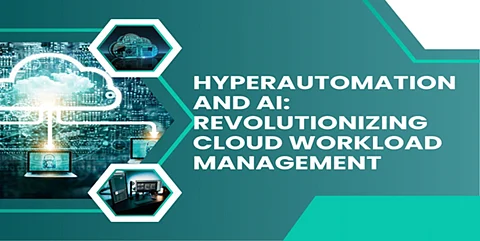Hyperautomation and AI: Revolutionizing Cloud Workload Management
In the dynamic world of cloud computing, the integration of artificial intelligence (AI) and hyperautomation is creating a transformative shift in cloud workload management. Pradeep Kurra’s article, Hyperautomation and AI: The Next Evolution in Cloud Workload Management, sheds light on how these cutting-edge technologies are addressing the complexities of modern cloud operations. The paper explores how the combination of AI and automation is evolving cloud systems from static, rule-based processes to dynamic, self-learning systems, ultimately reshaping how enterprises manage and optimize cloud infrastructures.
Transitioning from Traditional Automation to Hyperautomation
Traditional automation in cloud environments typically relied on static, rule-based systems that could only perform predefined tasks. These traditional methods, although effective in simple scenarios, have become increasingly inadequate as businesses scale their operations in multi-cloud environments. With enterprises managing multiple cloud platforms, inefficiencies such as long incident response times and resource wastage have become significant barriers to optimizing cloud performance. Hyperautomation introduces a major upgrade by incorporating machine learning and AI, enabling systems to not only perform tasks but also to learn from past operations, adapt in real time, and autonomously solve problems without human intervention. This shift enhances operational efficiency and reduces errors, as AI systems continuously optimize workloads and predict future demands based on historical data.
AI-Driven Transformations in Resource Management
One of the core innovations driven by hyperautomation in cloud workload management is the integration of AI for predictive scaling and intelligent resource allocation. Machine learning models, which are the backbone of predictive analytics, allow systems to anticipate demand fluctuations and adjust resources accordingly. This transformation reduces latency and resource contention issues that were common in traditional cloud environments. Predictive models can now optimize cloud resources with unprecedented accuracy, ensuring that systems scale automatically without the delays typically associated with manual intervention. By doing so, businesses experience improved application performance and a reduction in costs due to more efficient resource usage.
The Power of Self-Healing Systems
Hyperautomation doesn’t just enable smarter resource allocation—it also facilitates the development of self-healing cloud systems. These systems are capable of autonomously detecting and resolving issues such as performance bottlenecks or service disruptions, significantly reducing downtime. Leveraging AI-powered anomaly detection and root cause analysis, self-healing systems identify potential issues before they affect service quality. By automating the remediation process, these systems ensure that cloud infrastructures can recover from disruptions without human intervention, enhancing overall reliability. This self-healing capability not only improves uptime but also refines over time as the system learns from past incidents, adapting its strategies for future events.
Multi-Cloud and Edge Computing Optimization
In today’s multi-cloud environments, organizations are faced with the challenge of managing resources across a diverse range of platforms. Hyperautomation addresses this challenge by providing unified management across different cloud providers, ensuring that resources are allocated efficiently regardless of the underlying platform. Moreover, as edge computing continues to gain traction, AI-driven workload orchestration becomes essential. AI can intelligently distribute tasks between the cloud and edge, ensuring that latency-sensitive applications receive the necessary resources with minimal delay.
The Synergy Between 5G and Hyperautomation
The integration of 5G networks with hyperautomation is opening new gates in cloud workload management. 5G's promise of ultra-low latency and high bandwidth now means AI-driven orchestration offers more immediate task allocation with applications that require real-time processing. For instance, in autonomous vehicle- and smart-city-related fields, 5G and AI unite to effectuate swift, real-time adjustments to network conditions so that mission-critical applications continue to operate without interruption. As more enterprises are adopting 5G, the opportunities for hyperautomation to govern these fast-speed, heavy-load environments will only continue to grow, giving way to new categories of distributed applications that were until recently impossible due to latency or bandwidth constraints.
AI-Enhanced Cloud Security and Governance
Besides operational advantages, the rise of hyperautomation offers cloud security and governance measures. An AI system can utilize predictive capabilities to alert organizations regarding security threats before they actually develop, thus becoming critical issues. Through continuous monitoring through hyperautomation, it is ensured that cloud environments meet compliance standards and security protocols. Risk assessment by an AI goes into analysing threats, setting up countermeasures, and even having its systems act on them autonomously, thus lessening the human touch. Prevention in this regard, along with automation, proves to be one of the pillars of maintaining a highly robust and secure environment for cloud computing on the organization's side that restrains the ever-present threats of compromise or failure in compliance.
In conclusion, Pradeep Kurra perfectly encapsulated the integration of AI and hyperautomation as an exciting portal to transform the future of cloud workload. Any advances in AI set organizations increasingly so to face the complexities of today's cloud environments. Hyperautomation looks to increase opportunities for efficiency gains while simultaneously moving toward the possibility of full cloud autonomy, the very next evolution in cloud computing.
.png)

